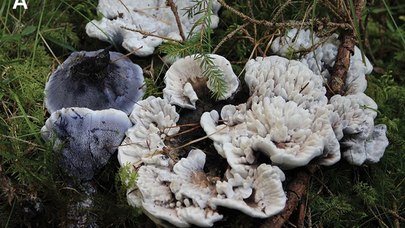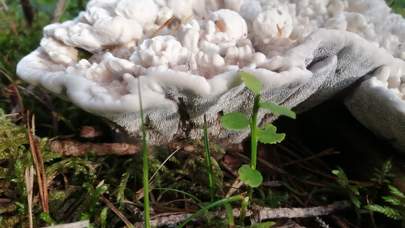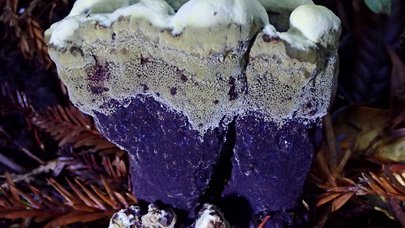Hydnellum suaveolens
Description
Hydnellum suaveolens is an inedible fungus often found beneath conifers. It has a funnel-shaped cap that is typically between 5–15 cm (2–6 in) in diameter. It has a strong odor of anise or peppermint.
Common names: Sweet-Smelling Hydnellum, Sweet Spine, Wohlriechender Korkstacheling (German).
Mushroom Identification
Ecology
Mycorrhizal with conifers (especially spruces); growing alone or gregariously; summer and fall; widely distributed in northern and montane North America, and on the West Coast from the San Francisco Bay Area northward.
Cap
Usually single but occasionally fused with other caps; 5–15 cm wide; convex, becoming flat; dry; velvety; becoming wrinkled, ridged, or pitted (sometimes cracking up into scales); white to whitish or very pale yellowish when fresh and young, becoming dingy grayish to brownish or olive over the center.
Undersurface
Running down the stem; covered with crowded spines that are 3–7 mm long; whitish at first, becoming brownish to brown as the spores mature.
Stem
2–5 cm long; 1–3 cm thick at apex; more or less stubby and cylindric; purplish-blue; bruising blackish-blue where handled; dry; velvety.
Flesh
Whitish to brownish, with zones of blue or brown (especially in the stem); tough but pliant.
Odor and Taste
Odor strong and fragrant or minty, often developing slowly after the mushroom is picked; taste mild.
Chemical Reactions
KOH on flesh bluish.
Spore Print
Brown.
Microscopic Features
Spores 4–6 x 2–4 µm; irregular; nodulose; hyaline to brownish in KOH. Clamp connections are present.
Medicinal Properties
Antioxidant activity. Fractionation of methanol extracts of the fruit bodies Hydnellum suaveolens resulted in the isolation of two new p-terphenyl derivatives named hydnellins A and B as well as sarcodonin δ (previously identified in Sarcodon scabrosus) (Hashimoto et al., 2006).
Look-Alikes
-
Has a cap with a white to blue margin and brown disc, the context in the stipe base is rusty to reddish-brown (not blue), and the odor and taste are farinaceous.
-
Similar, but its cap and flesh are bluer; additionally, its surfaces bleed red droplets when the mushrooms are fresh and young, and its spores are cruciate. It is associated with Sitka spruce.
Photo sources:
Photo 1 - Author: Annwahl (Public Domain)
Photo 2 - Author: Authors: Larsson K-H, Svantesson S, Miscevic D, Kõljalg U, Larsson E (2019), correct: Jerzy Opioła (CC BY-SA 4.0)
Photo 3 - Author: Annwahl (Public Domain)
Photo 4 - Author: Johannes Harnisch (Johann) (CC BY-SA 3.0)
Photo 5 - Author: Ron Pastorino (Ronpast) (CC BY-SA 3.0)





